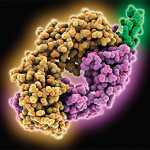The tailored-infusion arm received 248 infusions compared with 381 in the scheduled group.
Relapses at Month 28
At Month 28, 21 patients had suffered 22 relapses. Of these, 13 patients with 14 relapses (17.3% of the group) were in the tailored-infusion group, and eight people suffered eight (9.9%) relapses in the scheduled-infusion population (P=0.22). Comparing secondary endpoint of relapses, tailored vs. fixed-schedule relapse-free survival rates were 83.8% (95% confidence interval [95% CI] 76.1% to 92.3%) vs. 86.4% (95% CI 79.2 to 94.2) (P=0.58). Major relapses occurred in six (7.4%) vs. three (3.7%) patients (P=0.23).
Glucocorticoid dose and duration did not differ significantly. Twenty-five patients stopped glucocorticoids during the study, but discontinuation was not associated with relapse.
The authors noted the study’s strengths include the fact that it was a multicenter trial using a reinfusion-decision algorithm applied to the experimental arm. The study’s limitations include its open-label nature, the fact that biological parameters were assayed in each center instead of a central laboratory and the fact that interassay variability was not evaluated prior to the study starting.
The Takeaways

Dr. Charles
According to study author Pierre Charles of the Department of Internal Medicine at Institut Mutualiste Montsouris in Paris, “This strategy did not lead to a statistically significant difference in the number of relapses even with the fewer infusions.”
The tailored-infusion arm received 248 infusions compared with 381 in the scheduled group. The medians (interquartile range) were three (ranging from two to four) vs. five (all received five), respectively.
“Fewer infusions were needed when using the individually tailored strategy of rituximab re-administration based on ANCA and circulating CD19+ B cells,” says Dr. Charles. “Although ANCA evolution and/or circulating CD19+ B cells were not reliable predictors of relapse, combining them still achieved fewer infusions in the tailored-infusion arm without significantly more relapses.”
“There are three important takeaways from our study,” says Prof. Guillevin. “Rituximab is the best treatment to maintain AAV remission, a reinfusion strategy based on ANCA and circulating CD19+ B cells could be used to reduce the number of needed rituximab infusions, and ANCA positivity and/or presence of circulating B cells are not useful in predicting relapse in these patients.”
Angelo L. Gaffo, MD, MsPH, is associate professor in the Rheumatology Division at the University of Alabama, Birmingham. He says this is a well-done study by a group with a very good track record in research-related AAV.
“The question on how to use rituximab to maintain remission is still pretty much unanswered,” he says. “This study gives us guidance on how to not only use rituximab as a maintenance drug, but also what role ANCA antibody and CD19+ B cell testing can have in decision making in cases of vasculitis. This is a major contribution because until now there were no known studies that have explored this situation with such rigor.”

